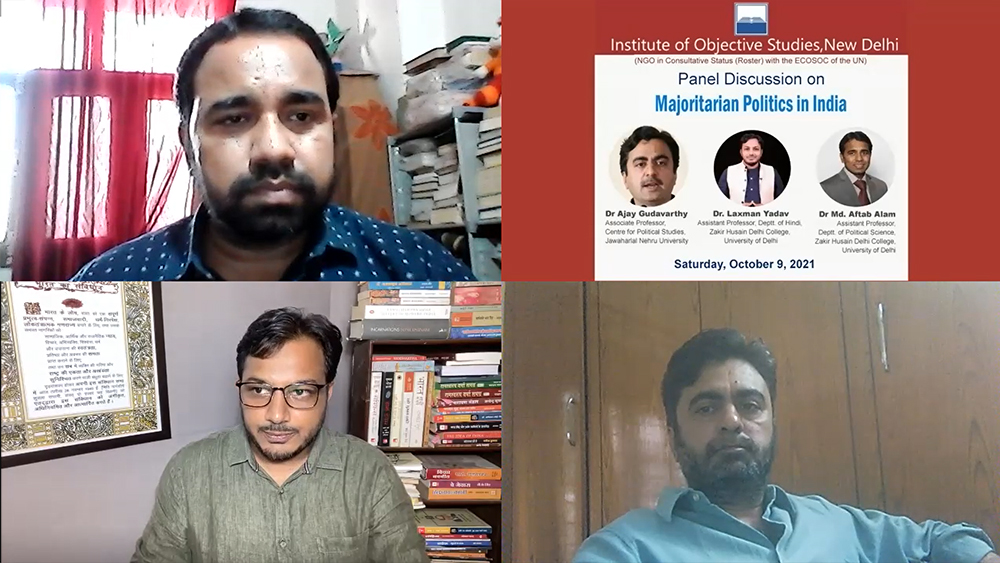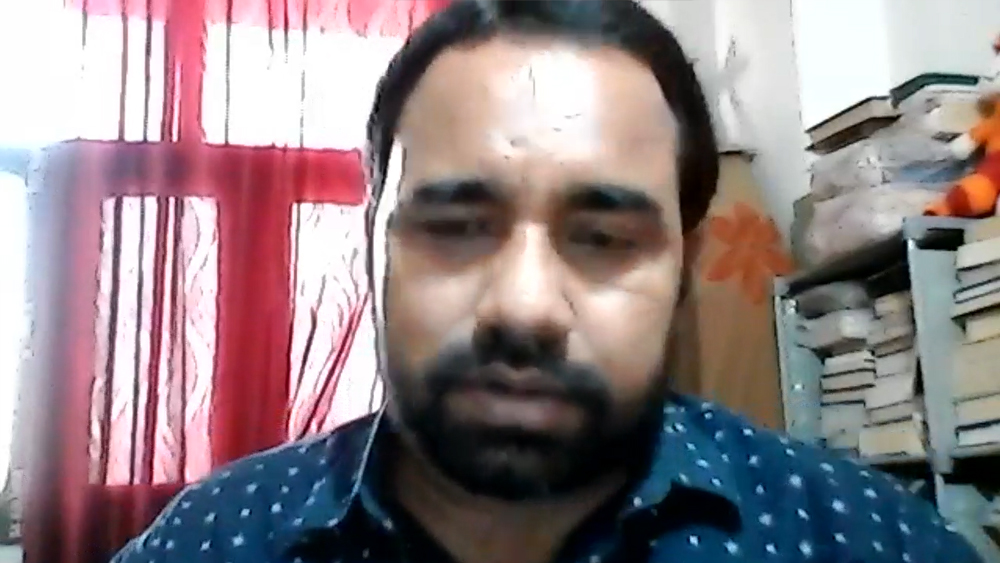IOS online panel discussion on Majoritarian Politics in India

An online panel discussion on “Majoritarian Politics in India” was organised by the Institute of Objective Studies on October 9, 2021.
The discussion began with the recitation of a Quranic verse by Hafiz Athar Husain Nadwi. Presided over by the secretary general, IOS, Prof. Z.M. Khan, the theme was introduced by the assistant professor of Political Science, Zakir Husain Delhi College, Delhi University, Dr. Aftab Alam.
In his introductory remarks, Dr. Aftab Alam said that majoritarianism was a serious threat to the essence of democracy. It asserted that the numerical majority of a population was entitled to a certain degree of primacy in society and had the right to make decisions that affected it. He observed that in the recent past, increasing majoritarianism and political polarisation had been witnessed in the country. It was a commonplace among political scientists that the polarisation in India was more toxic today than ever before. Calling the topic relevant in today’s context, he said that India was witnessing the shift of population myth to majoritarian nationalism. New form of nationalism had emerged in the country, which could be understood in global perspective. While new nationalism was excluvist in nature and confined itself, it was rooted in cultural nationalism. It was marked by nativism and ethnicism. Its permutation posed a serious threat to democracy and country’s pluralism, which existed since centuries. The wave of new form of nationalism gave rise to populism as well as vigilantism in the name of Gau Raksha (Cow protection), Romeo group, etc. He said that the Modi government passed certain anti-Muslim laws, anti-conversion law being one of them. The RSS-type majoritarianism was causing serious damage to the diverse culture of the country, called ‘unity in diversity’. In order to implement the Hindutva project and cultural nationalism, the politics of hate was being pursued by means of banning slaughter houses, mob lynching of innocent Muslims, targeted violence against Muslims and Christians and attack on Churches. The bogey of love and Corona jihad was raised to instigate the majority community against Muslims. Tabhligi Jamat was targeted to malign the Muslim community, he noted.

Dr. Alam said that new things were being added to jihad. Continuing the stance of Godi Media against Muslims was adding insult to injury with the facts of issues being suppressed to give communal colour to them. The calling of Azaan on the mike was being made an issue to play up sectarian sentiments. A similar move to erase history was being made by the Hindutva zealots to put research on the subject on the backburner. Educational and research institutions were filled with people inclined to the saffron background with little or no knowledge of the subject. Besides mainstream media, social media platforms, like Facebook, Instagram, WhatsApp and Twitter were being systematically controlled by the fringe organisations of the Sangh in contradiction to secular values, he added.
Asstt. Professor, department of Hindi, Zakir Husain Delhi College, Delhi University, Dr. Laxman Yadav expressed concern over falling values in politics. It was a moot question today how to view majoritarianism. Every narrative had been so simplified that the gap between facts and arguments was closed, leaving no room for enquiry. The debate in the corridors of politics had become hollow. He opined that the narrative of the nation and democracy had two aspects. While one was theoretical, the other was practical. The question arose if the promises made on January 26, 1950, were fulfilled. He sought to know what type of life a citizen was leading. As a citizen, one’s faith should not be allowed to be shaken. He wanted to know what was the faith that was reposed in democracy. India ultimately became a secular state with no religion of its own. At the time of Independence, contradictions were many, some in the name of religion or language. The concept of religion implied that no citizen would be discriminated against and decisions to be taken on the basis of numbers. All the institutions of state were mandated to hold elections with the resolve to express faith in them. He deplored that those raising their voice in favour of the Constitution were behind bars. These were students and those who raised their voice against CAA, NRC and NPR. Instead of demanding the rights, today’s crisis hinged on saving the existence. He observed that multiple identities were overlapping, leading to the clash of identities. As far as caste configuration was concerned, depressed, exploited, and deprived sections constituted 54 per cent of population. If the scheduled castes and scheduled tribes were added to it, the total population made up to 85 per cent. Social ideologies identified Hindutva with majoritarianism. Hindu Mahasabha was active in UP since 1938, and in Bihar since 1930, he noted.
Dr. Yadav argued that the new national narrative of social justice emerged in 1990, and efforts were made to sharpen it. In order to counter the narrative of social justice, Hindutva forces embarked on the Kamandal (Temple) movement that was marked by riots in the country. The movement paid handsomely to the Hindutva forces, and the new government installed in 2014, invented a new slogan ‘Sub ka Saath Sab ka Vikas’. This was replaced with ‘Subka Vishwas’ in 2019. The intent of these slogans became loud and clear by 2021, when PSUs (Public Sector Undertakings) were put on sale. With the birth of new nation-state in 1950, it was expected that the promise to grant ownership rights of the land would be fulfilled and the government would provide medical and health services and education to the people. But the entire narrative changed with love jihad, madarsa, triple talaq, etc., becoming the catchword. This discourse did not include poverty, unemployment, healthcare, education, etc. The current year was marked by the power gradually shifting to the private sector. He insisted that citizens were given the right to vote, but equality, education and health were a far cry. There was no discussion on more than 300 mob lynchings. The deprived and exploited were the target of majoritarianism. He opined that nobody would be spared of the onslaughts of majoritarianism. Only 15 per cent who were at the vanguard of majoritarianism wanted to make everyone Hindu. Vague nationalism and false history formed a part of the big project to divide people on communal lines. He called for defeating fake majoritarianism. The country was currently in the throes of a grave crisis, and it was the duty of every Indian to make a critical assessment of the period between 1950 and today. The politics of social justice had to be pursued with renewed vigour to realise the idea of a nation as visualised in the Indian Constitution, he added.
Associate Professor, Centre for Political Science, Jawaharlal Nehru University, Dr. Ajay Gudavarthy, held that majoritarianism did not hinge on numbers only; it sought to establish a social identity and social structure. There was a powerful and privileged class that wanted to bring together other majoritarian population. There was a need for social ethics, notion, ideas, etc., to overthrow majoritarianism. There was also a social and philosophical aspect to majoritarianism. Majoritarianism could not be removed by either population or the numbers singularly. Population and numbers together with the social ethics could defeat majoritarianism. He said that anti-Muslim and anti-Dalit discourse was couched in something else. Counter-assertion too could not defeat majoritarianism. It was the ethics and everyday practices that made majoritarianism powerful. He maintained that the engagement of secularism was failing to counter majoritarianism. Hindutva was conscious of the modalities in different sections. Hindutva project was much deeper than it appeared to be so because it got strengthened through everyday practices, he noted.
Dr. Gudavarthy pointed out that the generic norm had been institutionalised. He said that staying of Muslims in India in the wake of Partition was the trust laid on Hindus. Neo-liberalism also had a contributory role in the rise of majoritarianism. India had become anxiety-prone today. Ethics and anxiety among majority regarding CAA had been generalised. Generic anxiety, a mental and social state, was coming from neo-liberalism, and unless alternate ethics was developed, it would be difficult to defeat majoritarianism. He pointed out that societal majoritarianism made it blind to reason. Secularism and social justice could challenge majoritarianism. Commenting on the current dispensation, he said that they violated all norms during the last seven years to the extent that it was inimical to them as well. In this connection, he cited the instance of Kumbh fair which was organised despite Covid-19 pandemic unmindful of the fact that it infected several sections of society. Hegemony through lawlessness was another aspect of majoritarianism. It also encouraged mediocrity, which was reflected in its actions in contradiction to constitutionalism. They had an unprofessional approach to the appointment of the bodies that required specialised incumbents. They appointed those who were unprofessional; he noted.
Dr. Gudavarthy observed that the Hindutva politics was against change. Majoritarianism needed to be understood in the context of the power they wielded. Thus social and political power was needed to create opposition. Referring to the AIMIM leader Asaduddin Owaisi, he said that he (Owaisi) was working in tandem with the BJP to cut Muslim votes in the areas where they had concentration of their population. So was the Samajwadi Party, which remained silent on Muzaffarnagar riots. Congress Party too kept silent on the lynching of Pahlu Khan. Secular politics could counter generic insecurity that had grown over the years. The RSS also operated through the social media and expanded its network. Muslims and others should demand that a truly secular welfare state should be in place to implement welfare schemes. Secular politics should not be confined to one community. At a time when the RSS was building a monolithic project to assimilate castes, there was an urgent need to break sectarianism and promote secularism. It was also obligatory on every conscientious person to question his own internal dynamism of contradictions. There should be no exclusivism within the community. He called for achieving the ability to speak for others and raise questions, along with the representatives of other communities, be it the farmers or other sufferers. There was a commonality that the Hindutva project did. That was the reason why it termed the Sikh farmers as Khalistanis and called JNU students urban naxals, he concluded.
In his presidential remarks, Prof. Z.M. Khan said that the panel discussion was very useful to understand the niceties of Hindutva politics. He held that secular politics was the only answer to the politics of sectarianism, promoted by the saffron brigade.
At the end, Dr. Aftab Alam, while proposing a vote of thanks to the participants, observed that a kind of social ethics, ability to put questions, self-righteousness, and social behaviour were the norms to counter majoritarianism.
Go Back